

Version 1.0 last revised on 6/04/2001. Any comments or suggestions please direct them to Vorlon001
This
Guide is maintained and hosted by The Vorlon Homeworld. Linking to this guide is
ok, however anyone interested in hosting this guide must first contact Vorlon001
for approval.
PLEASE
READ, VERY IMPORTANT:
The
use, possession or importation of Test (Programmed/Pirate) Cards is Illegal in
the United States. If you are a U.S. resident, you are required by law to
subscribe and use of Test Cards of any kind is unlawful and subject to Criminal
and Civil penalties according to U.S. law. We do not condone use of Test Cards
to U.S. residents. You and you alone are SOLELY responsible for abiding by the
laws of your Country, State, Province or Territory. THE DSS UNDERGROUND and THE
VORLON HOMEWORLD WILL NOT BE HELD RESPONSIBLE FOR THE ACTIONS OF THE PEOPLE
USING THIS DOCUMENT. This Guide is strictly for Canada and EDUCATIONAL USE ONLY.
Also the DSS Underground and The Vorlon Homeworld does not and will not
take any responsibility for what might happen to any card using the following
procedures. In other words, USE THIS
GUIDE AT YOUR OWN RISK.
So with that out of the way let us say that what we are trying to offer here is a basic and simple instruction that hopefully will make everything as easy for you as possible. We also want these instructions as safe as possible, meaning we want to try our best to avoid having your card become damaged. But remember nothing is absolutely foolproof and donít let anybody ever tell you differently. There is always a risk taken whenever you attempt to clean an HU card. But also at the same time if you follow certain precautions you can lower those risks and that is what we have tried to do with this guide. But sometimes people, when they run into an error or when they get confused about what they are doing, will guess or attempt to try things on their own resulting in creating possibly a more serious problem. If during any of the following instructions you should get any kind of error message or if you become confused and donít understand something stop immediately, make note of any on screen message(s) and then go to your favorite Forum Site and seek out advice. Usually there is always somebody online that will be more than glad to help you out. If you do need to seek out help again please be specific when posting your problem and also give as much detail as possible. I also recommend that you allow this page to load and save the entire web page to your computer. This will allow you to have it for future reference. It will also load much faster off line!
HU Eclipse is one of the safest and easiest of the most recent software available. In using this program, I recommend that you download the following software to work with it:
HUEclipse1.3 (Possibly the new 1.4a version, also) The version on this site is corrected for the glitching sequence.
HUProESI
Winexplorer 4.51
Hueeputil1.4a (Useful for converting .txt files to .bin files for use by Eclipse)
Equipment required:
1. A regular ISO Programmer. Necessary to check the ATR of the card.
2. A modified Unlooper or an HU Loader, known to be working correctly.
Read the card before you do anything else:
While this may sound like over simplification, I recommend this above anything else you do! For this purpose, I can recommend the use of HUProESI to do this. This is the only thing I recommend this program for. Like all of the HUPro variants, this original program is stable and works well for reading cards. I do not recommend it for programming, due to the fact that too many people have made mistakes with the renaming of the input.hex files and have cause themselves a lot of problems with this.
When you bring up HUProESI it will be set in this state. First select your com port.
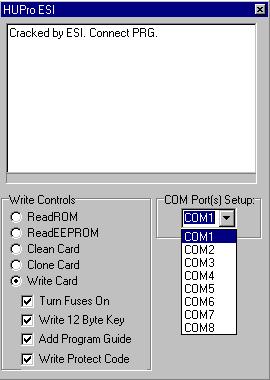
Bring up the HUProESI program and click on the read eeprom function. All of the write features will gray out and the program will only read the card without marking it. Make sure you have selected your proper com port. When asked, insert the card and allow it to glitch. When a read is done, the blue action line will indicate it and you will be asked to remove the card. Close the program, go to the HUproESI directory, and rename the eprom.txt file to the number on the back of the card that you just read.
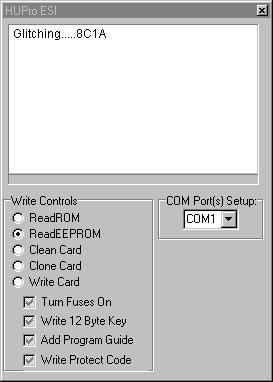
After selecting Read EEprom and insert the card, the program will start the glitching sequence. This may quickly work or sequence through a number of glitches like Eclipse does, before it catches.
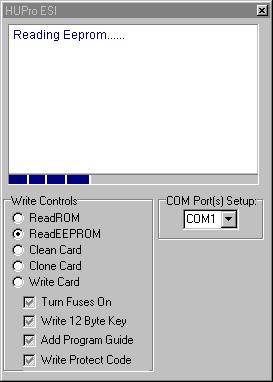
When the glitches, the card will be quickly read. The Eeprom image will be stored in the HUProESI directory as EEPROM.TXT. When prompted, remove the card and close down the program.
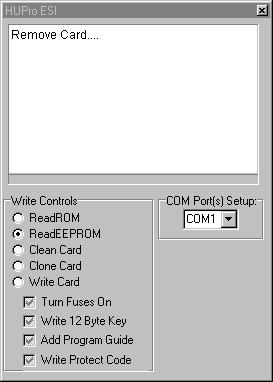
Using Explorer or My Computer, go to the HUProESI directory and rename the EEPROM.TXT file to the full card number that appears on the back of the card. Failure to do this will cause the next read to overwrite the original you saved!
Programming the card:
1. Bring up Winexplorer 4.51. Set the quick settings to Unlooper.
2. Select the open icon or under File, open script, and load Eclipse1.3 Your screen should look like below. (I usually close the batch Window as it is not used.)
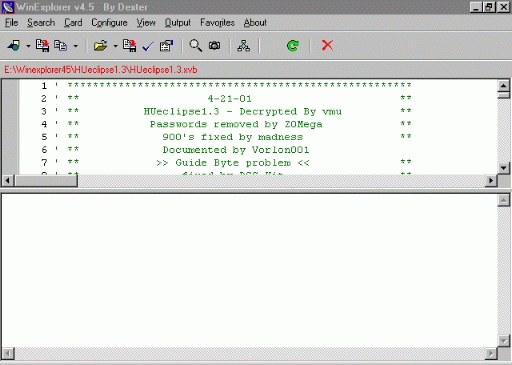
3. Select the Run Script icon to start the program. (The HU Loader must be connected and powered up.
The following menu will appear in the middle of the Winexplorer screen.
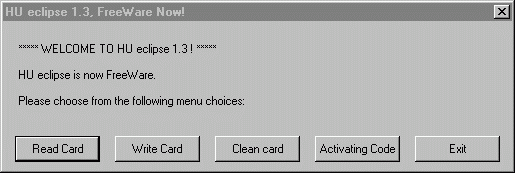
4. If you do not wish to use HUProESI to read the card, select the Read card button and click on it. The following screen will appear.
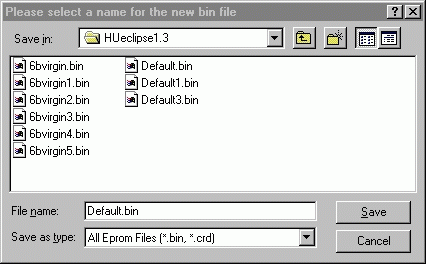
If you only select Default.bin, the following screen will appear.
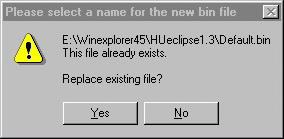
5. Select a name for your .bin file you will be saving (I recommend the ID from the card), and click on the save button. The following screen will now appear in the program, asking for you to insert your card.
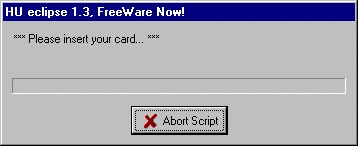
6. Insert your card at this point and the read glitching sequence will begin.
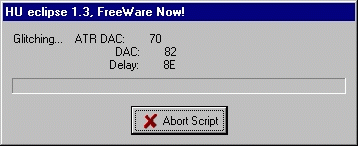
6. When the glitch catches, the card will begin to read the eeprom. I simulated the read and write screens in this document because using a frame grabber while reading or writing, could possibly loop a card due to an interruption of the process. The Winexplorer screen is suppressed to keep the size of the images down as the page load is large enough as it is.

7. After the read, the file will be saved and you will be returned to the main menu.

8. To activate a card, select the Activating Code option. The card does not have to be at USW1 for this. You can activate a Virgin card or a currently Subbed card. It is not recommended you do this on a previously subbed card that was shut down.
The first screen to appear will be as follows: Select a number from 1-20 and hit OK. It is not recommended that you select #7 as a choice.
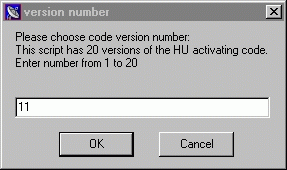
The second screen to appear is as follows: Simply select the time zone you want or use the More Option for other selections.
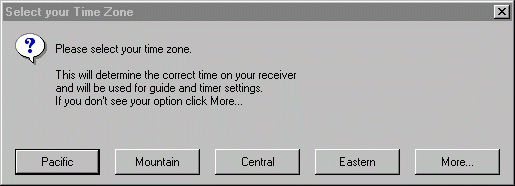
The third screen to appear is as follows: Select Daylight or Standard Time.
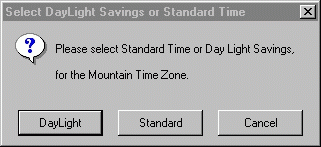
The fourth screen to appear is as follows: At this point, enter the zip code you want to be on the card. It should match the time zone. Once entered, click on OK.
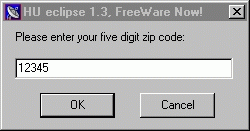
The next screen to appear will ask you for a guide byte. It is recommended that you use the recommended one. I would not use FF as it is not normal and could be a serious target. Click on OK when selected or entered.
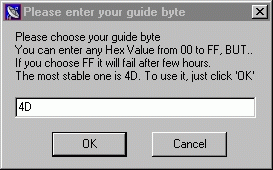
You Will now be asked to insert your card. Simply insert it at this point.

The glitching sequence will begin upon card insertion.

When the glitch sequence hits, the activation code will be written to the card.
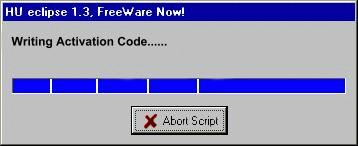
Once the quick write is completed, you will be returned to the main menu. Simply remove your card. It is ready to go. You can exit the program from here if you wish or continue with another card.

9. You can use the clean card option to remove HU Eclipse from your card. It will also repair the 4th byte of ATR 00 problem and return it to 25 as it should be. The clean routine is very thorough and should remove virtually any 3M on the card. As before, you will be prompted to insert your card, the glitching sequence will go on, and when it catches, it will write the cleaning code to the card.
10. The last option is the Write Card option. This will allow you to write a .bin file as saved by Eclipse or converted from a text file by one of the available programs. If you click on this option, the following screen will appear: Select the .bin file you wish to write to the card, and click on open.
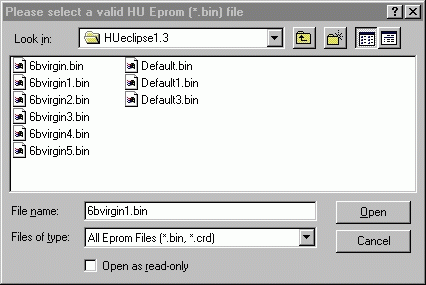
The insert card screen will open. Simply insert the card at this point.

After you insert the card, the glitching sequence will start:

When the glitch sequence catches, the clone bin will be written to the card.

When completed, you will be returned to the main menu. At this point, you would select the Activate Card Sequence and put the activation code on the clone.

This script based software is tested, stable, and assuming that your loader clock frequency is correct and a daughter board circuit is present, will load 100% of all cards with no problems. For extremely stubborn cards, look at the modification page on this site for the addition of a 100ohm pot on the ground side of the card. A slight adjustment of this pot can increase your ability to load difficult cards. Read the warning with the schematic of this, please!
This guide was saved from the Vorlon Homeworld! You want to claim one, write your own! The images were created by me and are copied from no one. Vorlon001.

This Document is (c) copyright 2001 by Vorlon001, all rights reserved.